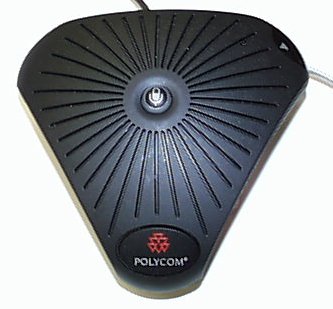



 
Next: 6.2 Sound Check (Audio Meter)
Up: 6 Sound
Previous: 6 Sound
6.1 Microphone Positioning

Video Conferencing Microphone Pod
Video conferencing microphone pods (see illustration) should be placed
slightly in front of meeting participants. As people usually look at
the TV monitor when speaking, try to place the microphone pods in the
direction in which they will look when facing towards the TV.
Presentation speakers tend to face their projected slides (and thus away
from the usual microphones) and may also move around. These traits,
and noise from fans in projectors, can make it trickier to place
microphone pods for a presentation than for a conversational meeting.
At least one microphone pod at each site should be on a long cable to
allow flexible positioning (but microphone cables should not be longer
than 60 feet). The Polycom
ViewStation has an auxiliary audio input that can be used with a lapel
microphone to ensure good audio from a presentation speaker.
(This has worked very well in some NRAO settings).
If you need to change the position of a microphone pod during a
meeting, press the MUTE button first (to avoid deafening listeners at
other sites while your pod is moved). There is a MUTE button at the
center of each pod as well as on the video remote control.
Presentations from a large room such as an auditorium will almost
always require the use of extra microphones if you wish to capture
both the speaker's presentation and an audience discussion.
One arrangement that has worked well for presentations in large
rooms (e.g. colloquia and conference sessions)
is to use just one Polycom microphone pod
close to the presenter, and then to mix in audio from independent room
microphone(s) to capture audience discussion. Thie single Polycom pod
can then use its internal switching to select the best way to detect the
speaker, maintaining the needed balance with a preset audio
level for the audience. (This approach works much better than
placing the second Polycom pod in the audience, as the Polycom system
may decide to switch to this second pod in response to sounds from
the audience, and thereby mute the presenter
at inappropriate times.)
An alternative approach for large rooms is to give the presenter(s)
a independent lapel microphone connected to auxiliary audio input,
to place both Polycom pods in the audience, and
to adjust
the level on the lapel microphone so that the presenter is always audible.




 
Next: 6.2 Sound Check (Audio Meter)
Up: 6 Sound
Previous: 6 Sound

Home |
Contact Us |
Directories |
Site Map |
Help |
Search
|




